Why Is Food Safety Important In Healthcare? Healthcare Leaders Guide
Learn challenges healthcare foodservice teams face today and key food safety practices to protect vulnerable patients. Get a free healthcare leader...
Food labels allow producers to communicate what their products can offer consumers and keep them safe.
The first thing a customer sees in a product is its food label. These labels are not just ordinary tags but are critical tools for communicating product information to consumers. They are the gateway to understanding a product's composition, nutritional content, and safety information.
In today's age of diverse dietary preferences, health consciousness, and food allergies, food labels play a critical role. They help shape consumer choices, promote transparency by producers, and ensure the well-being of those who rely on the foods they purchase.
WHAT WE'LL COVER:
Food labels are informative tags featured on food packaging. The information that food labels provide helps improve consumer awareness and make more informed choices in buying products.
From a business perspective, food labels help businesses create a comprehensive traceability system with the information from food labels.
Food labels provide important details about the product's contents, manufacturer's information, nutritional value, ingredients, safety precautions, portion sizes, and more.
This set of information is critical in ensuring accountability among food businesses. The information can be used to track the movement of products along the supply chain and determine which batches are safe or unsafe in case of widespread contamination.
Food safety agencies strictly regulate the information that goes into labels for food packaging to ensure that they are correct, accurate, and consistent.
Food labels are often printed or pasted onto the original product container for pre-packed food products. For fresh food types or non-prepacked food, paper labels are often used with adhesive tapes.
Food labeling is the process of providing a product's identity, contents, storage information, handling, and safety precautions, typically in the form of labels or tags.
Labeling foods is a common and essential food safety requirement to help prevent unwanted food safety incidents and promote healthier consumer choices.
Food safety labels are specific product tags, symbols, or labels on food products that specifically relate to food safety. They are designed and used to inform consumers about the safety and handling instructions of a particular food to prevent foodborne illnesses.
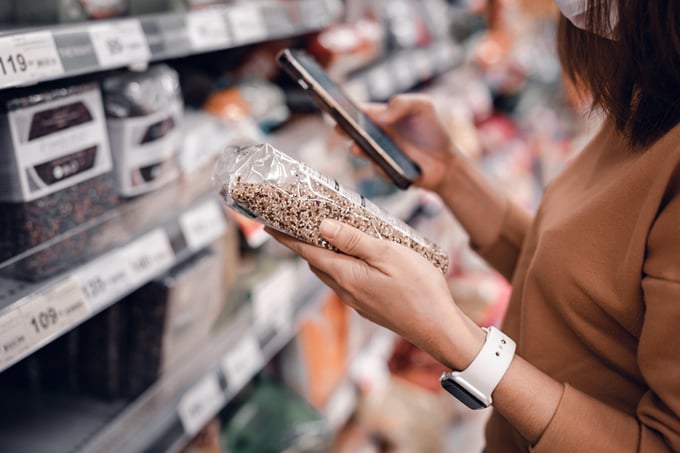
Food safety labels are critical in preventing foodborne illnesses and related incidents to ensure the safe consumption of food products. The information that they provide is essential for guiding customers on how to preserve safety in foods from their end.
The labels can also be used for making comparisons between foods when making healthful food choices.
The main objective of food labels is to inform.
The type of food product label used in a product informs customers about a particular aspect of the product. The information customers get is a combination of the two primary types of food labels, which are:
Each type plays a distinct role in shaping our understanding of the foods in the market. All parts of standardized labels are mandatory as per food regulations, whereas some custom labels are optional but may play a significant role in other aspects of promotion.
Learn more about them below.
Custom labels are also known as proprietary labels. They provide information about the products given by the food producers themselves. This type of label may include branding, unique dietary claims, and marketing messages.
Custom labels provide producers with an opportunity to distinguish their offerings from competitors and connect with consumers on a personal level.
Some examples of custom labels include the following:
Custom labels are commonly used to illustrate individuality and branding in a product. They are used as a way of marketing the product to consumers through different messages.
Standardized labels, on the other hand, are regulated and mandated by government agencies. These labels follow strict guidelines and are designed to provide consistent and essential information to consumers.
These labels aim to provide transparency and safety among customers when they use your products.
Standardized labels include all primary parts of a food label:
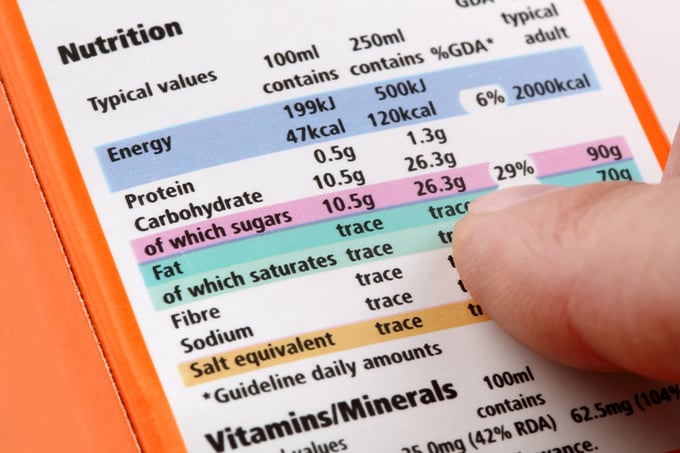
Government agencies establish these labels to ensure uniformity, transparency, and safety in the food industry.
They are made readily available for consumers to make informed choices and protect themselves from unwanted food safety incidents.
Food labels are required to provide specific information about the products to consumers. Such information will help describe the nutritional value, safety, proper handling, and storage of the food products. The information will also help mid and end users, including retail food establishments and consumers, keep the products safe.
The exact requirements for food labels may vary by country, but there are common elements found on food labels in many regions.
Here is the list of the information that is mandatory to have on the packages:
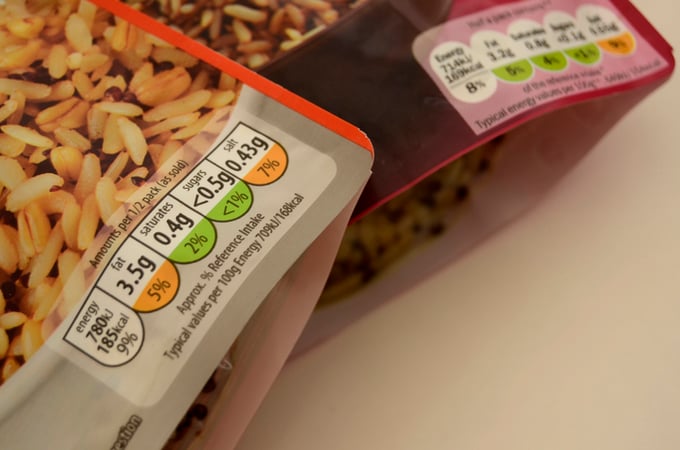
To ensure compliance with local food labeling regulations, manufacturers and producers must adhere to the labeling guidelines and standards established by the relevant food safety authorities in their region.
Regardless of which information applies to your business, it is critical that every food business operator has complete records and control of food label information. Use FoodDocs' smart Food Safety Management System that features a Digital Recipe Book, which compiles and organizes all food label information of your products.
Using this software feature, you can upload all critical information about your product into our system. Information is then presented to your team members as an organized recipe book. Keep ingredients, special preparation techniques, dietary claims, and other information all together in our Digital Recipe Book.
The Nutrition Facts label is a standardized panel found on most packaged food products. This label provides information about the product's nutritional content to help consumers make dietary choices.
The label includes the following key components:
Food package nutrition labels are essential for consumers as they will help them determine the nutritional intake they make. The information in this panel is also critical for individuals on strict daily diets.
Experts use this packet label as a reference for nutrition advice on the essential vitamins an individual needs. They use this information to suggest healthier foods and friendly options to individuals with medical conditions.
Allergen labels are designed to inform consumers about the presence of a particular allergen in a food product. The food components listed in this label may vary from one country to another.
Allergen labels are critical for people with food allergies or sensitivities, as accidental consumption of allergenic ingredients can have severe health consequences.
Allergen labels may also include information about potential cross-contact risks, especially in facilities where allergenic ingredients are processed or packaged. These labels are mandatory and marked alongside the ingredients list.
Food labeling requirements include regulations and standards set by government agencies to ensure that useful information about safety and health is indicated in labels. These legal requirements help regulate the food industry and ensure public health safety.
Some basic labeling requirements for food include the following:
Food producers are responsible for knowing and understanding the particular labeling requirements applicable to their products.
These basic label requirements aim to ensure that consumers have access to accurate and helpful information about the food products they purchase and consume. The accurate information can help them make more informed food choices and reduce the likelihood of chronic diseases or unwanted allergic reactions.
Food safety and labeling are regulated by government agencies that are responsible for ensuring the safety and integrity of products in the country. The particular agency responsible for food safety and labeling varies from one country to another.
Food safety is primarily regulated by both the Food and Drug Administration (FDA) and the US Department of Agriculture Food Safety and Inspection Service (USDA FSIS). Regarding food labeling, the FDA provides most of the regulations and labeling requirements, including nutrition labeling, ingredient lists, and health claims on food packaging.
In the United Kingdom, the Food Standards Agency (FSA) is responsible for both safety and labeling regulations. The agency provides strict guidelines for ensuring that all foods in the UK market are safe for human consumption and accurately labeled.
Food labeling in the UK and the US has many similarities. Despite this fact, the food safety regulations in these countries have distinct differences regarding food labeling.
Here are some major differences between the food labeling requirements in the two countries:
Here is a quick summary of the major differences in US and UK labeling requirements:
| Aspect of Food Labeling | FDA food labeling guide | FSA labeling guide |
|---|---|---|
| Nutritional Pack Label Format |
- Calorie label based on number of servings per package. - Spelled-out macronutrients. |
- Calorie label based on 100g or 100ml. - Color-coded macronutrient labels. |
| Reference Values | - 2,000 calories for Percent Daily Values. | - 2,500 calories for Percent Daily Values. |
| Allergen Labeling | - Recognizes 9 major food allergens. | - Recognizes 14 major food allergens. |
| Date Labeling | - Uses "Best By" or "Use By" for product quality, not safety. | - Uses "Best Before" and "Use By" to indicate product safety. |
| Organic Food Labeling | - "100% Organic" for pure organic products. - "Organic" for at least 95% organic ingredients. - "Made with organic" for 70% organic ingredients. | - "100% Organic" for pure organic products. - "Organic" for at least 95% organic ingredients. - "Made with organic" for 70-95% organic ingredients. |
Keep all food label information organized using FoodDocs' intuitive Food Safety Management System. With the help of our smart software and our Digital Recipe Book, you can compile all critical information about your product.
Set up your comprehensive database of product information by simply mass uploading your recipes to our food system. All information, including name, ingredients, preparation instructions on labels, allergen information, and special storage conditions, will be immediately compiled for your convenience. The information will then be used to generate an allergen matrix and automatically resize recipes.
Food labeling is a critical aspect of any food product.
It is used to bridge a seamless communication between producers and consumers.
To help consumers select which products match their dietary preferences and health requirements, producers must provide key product information.
All food producers must comply with a country's food labeling rules.
Doing so ensures a safe and secure food supply chain for businesses and consumers. In case of problems, such as food recalls, your information will help agencies minimize damages.
Allow FoodDocs to help your business secure the traceability of your products. With the help of our two-in-one Traceability System with a production management module, you can create a comprehensive database of your products that can be used in cases such as food recalls.
Our Traceability System features advanced search options that allow you to sort information easily and download only the necessary information. Make recalls and other traceability activities easier and more efficient with the help of our smart software.

Food labels act as a way to communicate the main features of a product to consumers. They provide information about the ingredients, nutritional content, allergens, added value, and safety precautions tied to a product.
Food labels can help consumers make healthier choice and preserve the safety of products from their end. In cases of food safety incidents, they are critical in identifying the range of affected products that need to be recalled.
Labels in foods act as the main source of information about the product for both customers and food manufacturers.
Food labeling benefits both the customers and the producers. The label information found on food products helps you control the products released in the market.
In case of a food recall or any other food incident such as an allergen outbreak, producers can easily identify which batches are affected and must be withdrawn from the market.
In aiming to achieve the best results out of the benefits of food labeling, your food business must implement a comprehensive traceability system along with a food safety management system.
Get both systems with one software using FoodDocs' smart Food Safety Management System.
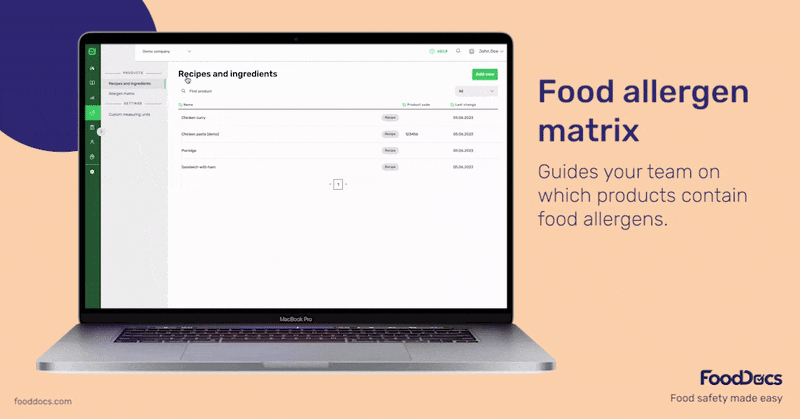
Manage food labeling information with the help of the following product features from FoodDocs:
Using our smart software, you can easily upload all product information that goes into your food labels using our Digital Recipe Book. With this feature, you can encode information such as the following:
All of this information will be organized and efficiently presented in one central Recipe Book.
Based on the information you add to the Smart Recipe Book, our software can automatically recalculate production yield and the required amount of ingredients.
Ensure that all food label information is accessible to your employees. You can use this recipe book as a reference for the product information that goes on your food labels.
An integral part of our Digital Recipe Book is its feature to automatically generate a comprehensive allergen matrix from your products. Based on the information you input into the recipe book, our system will automatically identify the relevant major allergens in each of your recipes.
The recipes will then be listed under an Allergen Matrix with the major allergens applicable to your business location. The matrix is automatically updated when you insert more recipes with allergens.
The Allergen Matrix is also customizable if you want to improve the information.
You can print the Allergen Matrix and add it to your menu labeling requirements or use the information to guide your employees on the allergens that must be recognized in the food label.
FoodDocs' Traceability System was built to allow you to track the movement of their ingredients and products in the supply chain. Use the information from food labels to identify the range of products affected by unwanted food incidents.
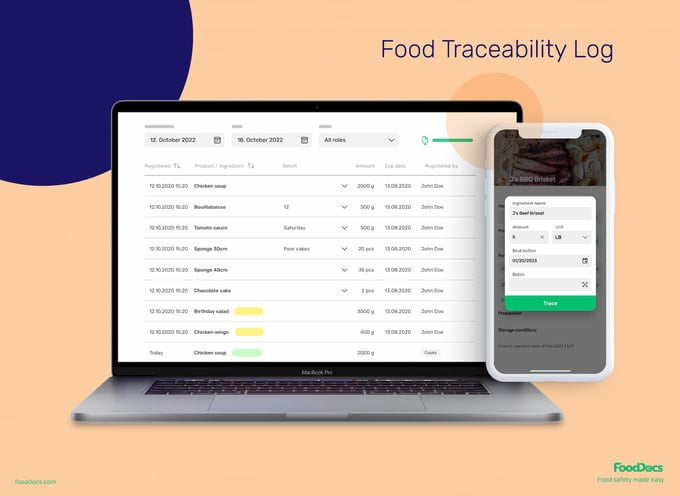
Counterchek production batch numbers on food labels to identify the extensiveness of food recalls or withdrawals to perform. Easily access information with our system's advanced search options.
Each traceability input can be further improved by attaching monitoring tasks from our system. Incorporate relevant monitoring tasks and logs into each batch entry as proof of compliance with regulations, including food safety and labeling.
Maintain complete control of your food safety status with the help of our real-time dashboard.
With the help of this monitoring feature, you can get a quick overview of your food safety status and save at least 20% of your time from managing your team. Quickly identify key areas affecting food labeling operations and immediately apply corrective actions.
Stay on top of all related food safety requirements by using our smart tool that will give you a summary of your operations.
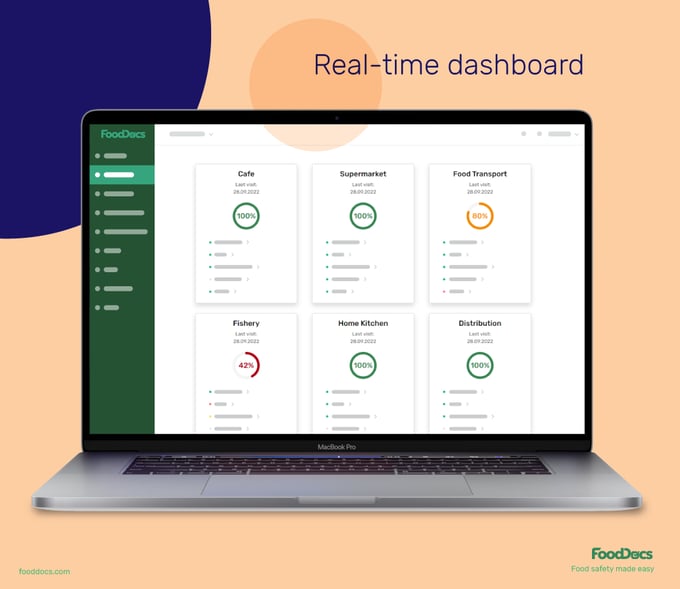
Ensuring proper food labeling is equal parts monitoring, traceability, and compliance with the relative regulations. You can easily achieve and maintain these three core requirements with the help of FoodDocs' AI-powered Food Safety Management System.
You can also keep all food label information organized and secured in a central system to ensure food safety while ensuring compliance with the essential food labeling legislation in your business location. Equip your team with the necessary tools to keep them ready to face unwanted food incidents and minimize challenges by keeping all traceability and label information in one accessible cloud space.
To help you understand more about food safety labels, here are a few of the most common questions asked regarding this topic:
Two purposes of product labels are (1) to inform consumers about the product's content and characteristics and (2) to establish brand identity and share marketing messages from producers.
Some of the mandatory mandatory information for a food product label includes the product name, the ingredient list, allergen information, the nutrition facts panel, and the manufacturer's contact information.
The correct way to label food involves following government regulations and standards, which vary by country. Food labels must accurately reflect the product's content and adhere to prescribed formatting and labeling requirements.
The five mandatory requirements for labeling packaged food include:
The FDA (Food and Drug Administration) in the United States has specific food labeling policies, including providing accurate nutrition information labels, allergen labeling, and adhering to guidelines for health claims and nutrient content claims.
New rules for food labels in the United States, implemented in 2020, include updated nutrition facts panel requirements, which now highlight added sugars, updated serving sizes, and adjustments to daily values for nutrients.
The 5/20 rule on food labels simplifies the provision of food information. If a food item has 5% or less of a nutrient's Daily Value, it's not a significant source, but if it has 20% or more, it's considered a high source, making it easy for consumers to judge the nutrition.
The 80/20 rule states that foods cannot contain more than 120% of the declared nutrient values or less than 80% of the actual values. This rule aims to limit the amount of macronutrients the consumer takes while ensuring sufficient nutrients are consumed.
Learn challenges healthcare foodservice teams face today and key food safety practices to protect vulnerable patients. Get a free healthcare leader...
Learn what Standard Operating Procedures (SOPs) are and how to write effective SOPs that ensure consistency, efficiency, and safety in your...
Boost your retail food safety with essential practices and digital tools to protect customers and your brand. Plus a free Retail Food Safety Leader...